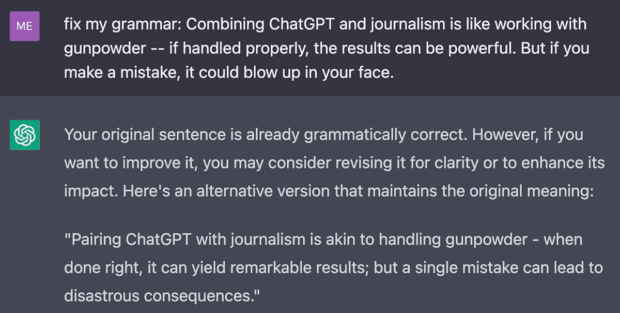Journalists are always looking for new and innovative ways to gather news and information. Is ChatGPT one of those new technologies that has the potential to revolutionize journalism? Can journalism and AI mix together without becoming toxic? Yes, but only if done very carefully. Need some ChatGPT examples for your staff? Here’s how to use ChatGPT ethically in a newsroom without compromising your journalistic principles.
Composing Social Posts
While many larger news organizations have a dedicated social media team, this isn’t always the case in smaller markets. Additionally, social media resources may not be available on weekends, overnights, or during breaking news events. As a result, creating social content often falls back onto the newsroom staff. However, ChatGPT can provide a solution by quickly generating social content for your news articles.
Try giving ChatGPT a URL and ask it to compose a post for a specific social media platform. In this ChatGPT example below, we asked the AI to create a LinkedIn post for an article about the history of the NBC Chimes.

You can also specify a tone for your AI generated social posts. In the NBC Chimes example above, we asked ChatGPT to write a post with a “serious” tone.
How Journalists Can Use ChatGPT Ethically - Great ChatGPT Examples That Can Make Your Newsroom More Productive #AIJournalism #EthicalAI #AI #ChatGPT #ChatGPTtricks #ChatGPTexamples Share on XHashtags: How To Use ChatGPT To Generate Hashtag Suggestions

If you are responsible for managing the social media accounts for your newsroom, then you probably will find this ChatGPT example on generating hashtags extremely helpful. Hashtags are an effective tool for linking related topics on social networks and increasing the visibility of your social media posts. However, creating a list of relevant hashtags can be time-consuming. Fortunately, ChatGPT can suggest relevant hashtags for you in just a few seconds, saving you valuable time and effort.
To get started, simply type in your post’s topic, URL, or keyword into the chatbot. ChatGPT will then generate a list of hashtag suggestions for you.

Do SEO Research For An Article
Newsroom staff are constantly asked to do more with less time. From adding stories to the CMS to writing social media posts and creating push alerts, there’s barely enough time to work on your actual news story. Another task being pushed onto the newsroom staff is SEO research. Unless you’re an SEO expert, researching search keywords for a news story can be a time intensive process.
But ChatGPT can save you time and help with your SEO research. Just paste a URL into the chat window and ask the chatbot to provide SEO key phrases for your article.

In another CHatGPT example, we asked the AI to provide SEO key phrases for an article about how car touch screens are distracting drivers. The results were actually really good! This is what it gave us:
- “car touch screens”
- “driver distraction”
- “touch screen car technology”
- “touch screen car systems”
- “touch screen car infotainment”
- “touch screen car controls”
- “touch screen car safety”
- “touch screen car complaints”
- “touch screen car dissatisfaction”
- “touch screen car alternative”
- “touch screen car issues”
- “touch screen car problems”
- “touch screen car dissatisfaction survey”
- “touch screen car usability”
Create A Summary From A Transcript
Posting a raw transcript online isn’t an ideal user experience for your audience. Usually a transcript needs some context, like an intro or summary. Although ChatGPT can’t transcribe videos yet (use a transcription service such as Trint, Rev.com, Otter.ai, or HappyScribe), it can quickly create a summary of a transcript for you.
We pasted a copy of Dr. Martin Luther King Jr.‘s “I Have A Dream” speech into ChatGPT and asked it to write a summary. ChatGPT spit out this response a few seconds later.
The speaker is addressing a demonstration for freedom and civil rights, and referencing the Emancipation Proclamation, which abolished slavery in the United States. He states that despite this historical progress, black Americans are still not free and face ongoing discrimination and poverty. He refers to the Constitution and Declaration of Independence as a promissory note that has not been fulfilled for black Americans. He calls for immediate action and change, and urges for peaceful and dignified protest. He also acknowledges the support of some white Americans in the fight for civil rights.
Asking an AI tool to write a summary can be a helpful way to get an overview of a long conversation, or to identify key points or quotes.
Journalists can save time by using ChatGPT to generate a summary of a transcript or speech. #AIJournalism #EthicalAI #AI #ChatGPT #ChatGPTtricks #ChatGPTexamples Share on XSummarize A Reddit Thread With ChatGPT
Popular Reddit posts can contain thousands of comments. For example, this Reddit post that asked, “What is the best animated movie and why?”, has almost 23,000 comments.
Trying to manually sort or rank the most popular movies talked about in the post could take, hours, even days. But ChatGPT can scan and rank the top movies mentioned in this thread in just a few seconds. It’s incredible!

Explain Complex Documents, Like Legal Filings Or Financial Reports
There’s a lot of important information contained in documents like legal filings or financial reports, but they can be tough to understand if you’re not an expert. That’s another way that ChatGPT can be helpful.
Try pasting a section from a legal contract into ChatGPT and tell the AI to explain it to you. ChatGPT is a great at explaining sophisticated documents or concepts in a way that’s easy to grasp, regardless of your prior knowledge.
What are you waiting for? Ask ChatGPT to explain concepts like critical race theory or quantum physics to you like you are in 5th grade.
WARNING: Be careful with what sensitive information you share with an AI. Chatbots like ChatGPT are constantly learning from their interactions with users. What you share with an AI may be reused and regurgitated to another user in the future.
Suggest Sources For A News Article
Need a source for your news story? Try asking ChatGPT for suggestions. We asked a chatbot to provide sources for this article and it made some really good suggestions.
If you’re using ChatGPT to find and contact sources, be transparent with them about how you found their information. Let them know that you’re using an AI-powered tool, and explain how it works. They might be both flattered and confused on why an AI recommended them.
Journalists also need to be extra cautious when using sources suggested by an AI. By suggesting specific sources to you, the AI can unknowingly be promoting bias.
Reformatting Text
Do you have a block of text that is in all caps or all lowercase? Just paste it into an AI tool like ChatGPT and ask the AI to reformat it for you.

Rephrasing Text & Composing Excepts
After creating a news piece, you or others in your organization will distribute it to a variety of locations. This may include social media sites, newsletters, and landing pages. But Google doesn’t like seeing duplicate content. Posting the same text in multiple places can even hurt your SEO.
So ask ChatGPT to rewrite something for you. Try pasting an article excerpt paragraph into ChatGPT and ask it to create an alternate version that you can use elsewhere without duplicate SEO concerns.
You can also ask ChatGPT to shorten a long paragraph, or write a shortened except that’s a specific amount of characters long.
How To Use ChatGPT To Fix Grammar & Proofread Text
ChatGPT is better at fixing grammar mistakes and typos than Microsoft Word. Try asking ChatGPT to spellcheck or fix the grammar of something.
Just ask ChatGPT to check your grammar and paste in a block of text.

Ask ChatGPT To Make A Paragraph “Flow” Better
Sometime when you’re writing, it’s helpful just to get your raw thoughts out and then go back a reformat your text. But ChatGPT can help with that too.
In this ChatGPT example, I took this choppy paragraph and asked ChatGPT to make it “flow” better.
She is tall. She is smart. She likes to volunteer. College is interesting but she might want to go into the family business instead.
Here’s what ChatGPT gave me. It’s more colorful, exciting, and engaging.

Changing Tone Or Tense Of Text
ChatGPT and quickly change the tone of a paragraph. In this ChatGPT example, we asked the AI to make our paragraph sound sad.

We then asked ChatGPT to make the same text more exciting.

You can also change the tense. Try asking ChatGPT to rewrite your text in the past or present tense. Or if you have an article that uses multiple tenses, ChatGPT can turn it all into a single tense.

Translating Languages
Language translation services, like Google Translate, usually do a great job. But sometimes they can miss the context or meaning of what you are trying to say. I’ve actually found ChatGPT to be better at generating a more natural language translation then Google Translate.
What about you? What kind of ChatGPT language translation results are you experiencing? Please let us know in the comments below.
How To Use ChatGPT To Write A Promo Script
Need to turn a news story into a promo script for your TV or radio station? Just give ChatGPT the URL of a news story and ask it to write a sample promo script for you. Use tone indicators like “exciting” or “sober” to change the style of the script.
In this ChatGPT example, we asked the AI to write a 15-second TV promo script about actor Richard Belzer’s last words.

How To Use ChatGPT To Generate Article Headlines
Sometimes writing a compelling headline can be as much work as writing the body of an article. Just give ChatGPT your working title and ask the AI to generate a list of alternatives.

You can even give ChatGPT your SEO keywords too and ask the AI to use those in the title it generates.
Brainstorm With ChatGPT On Content And Story Ideas
You can also use ChatGPT to generate story ideas. For example, let’s say you were asked to write an article about “10 fun ways for families to celebrate Mother’s Day in Seattle”, and you were only able to come up with seven items on your own. You can brainstorm with ChatGPT. Just ask the AI to give you a few additional ideas for family activities in Seattle to consider.

Do You Have To Reveal How ChatGPT Was Used To Create An Article?
As a newsroom, do you have to disclose that you used ChatGPT for your article? This is a complicated question for your news director.
In general, if you are just using AI for small tasks, like providing SEO key words or hashtags, then probably not. You are just using AI as a utility. In this case, your use of AI isn’t much different than using spellcheck.
But it’s a fine line between generating hashtags and asking the AI to write full paragraphs for your news story.
If you are using AI to generate summaries, or large portions of text, then yes, you should probably disclose how you used ChatGPT. Something like, “AI technology was used to automatically generate this video clip summary.” Disclosing how you are using AI will give your readers more confidence in the piece and help to build trust. Remember, people are more likely to believe something if they can see how it was done.
But don’t be stupid about how you use AI to generate content. Vanderbilt University foolishly used ChatGPT to write an email to their community about a mass shooting. They even proudly cited ChatGPT at the bottom of the letter. Not only was this insensitive, but there were some factual inconsistencies in the AI generated letter. Don’t be stupid like the staff at Vanderbilt University.
#ChatGPT Examples That Can Make Your #Newsroom More Productive And Show How #Journalism And #AI Can Ethically Work Together ... #AIJournalism #EthicalAI #ChatGPTexamples #ChatGPTtricks Share on XEstablishing Guidelines For AI Use In Newsrooms

If you haven’t already, you need to speak with your newsroom staff about the approved ways for them to use AI. You need to establish the guardrails before they go rogue.
The ChatGPT examples in this MethodShop article are fairly harmless. Asking the AI to generate hashtags or write a Tweet for a news article that you wrote won’t raise too many eyebrows.
However, using AI to write the news for you will only lead to trouble. The AI often gets things wrong, which means anything it writes needs to be checked and verified for accuracy. The juice may not be worth the squeeze. For experienced writers, it might be faster to just write the story from scratch rather than trying to fix all the ChatGPT mistakes.
What you want to avoid is the PR nightmare that CNET experienced in January 2023. Their staff used AI to write an article explaining how loans worked. Unfortunately the AI was completely wrong and CNET didn’t bother to fact check the story. Whoops! A couple months later, CNET’s unhappy owners announced a new round of layoffs.
Another thing newsrooms to be aware of, is the evolution of AI detection software. There are already a variety of free tools that let you scan content, including webpages, for AI generated text. In the future, the ability to review entire websites for AI content could be available. If your news site has a lot of AI generated content, this could impact things like your reputation, SEO, or credibility.
Why use chatbots in newsrooms when you have human reports? Can AI help increase productivity? #AIJournalism #EthicalAI #AI #ChatGPT #ChatGPTtricks #ChatGPTexamples Share on XChatGPT Examples That Show How Journalism And AI Can Ethically Work Together — But Only When Used Properly

Why use chatbots at all in the newsroom? Because ChatGPT is a powerful tool. When used responsibly, it can help you do your job better and faster. But when abused, it could have some very negative consequences for your organization and the credibility of your news brand. Combining ChatGPT and journalism is like working with gunpowder — if handled properly, the results can be powerful. But if you make a mistake, it could blow up in your face.
Combining ChatGPT and journalism is like working with gunpowder — if handled properly, the results can be powerful. But if you make a mistake, it could blow up in your face.
MethodShop.com
I’m a dog owner that loves poetry, vampires, mountain biking, and cosplay. I’m open to ideas and still trying to figure my SFO life out one blog post at a time. LF ISO SWF GSOH SI DDF.































 What Happened To The Goonies Pirate Ship?
What Happened To The Goonies Pirate Ship?
Leave a Reply